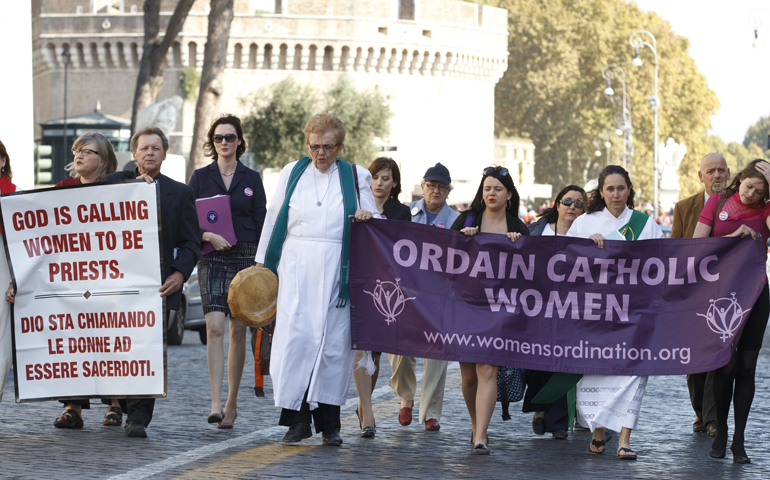
Maryknoll Fr. Roy Bourgeois marches down Via della Conciliazione toward the Vatican during a demonstration Oct. 17, 2011, in Rome. (CNS/Paul Haring)
One hundred years ago, Jan. 10, 1917, was a cold Wednesday morning. There was nothing exceptional about the day and that's important to note. Women's history isn't made in exceptional moments. It is often made by the long striving of a woman who has called together some friends for a cup of tea and their conversation leads to freedom, whether in society or the church.
I don't know if tea was brewed on this particular January morning, but I do know that after much discussion by Alice Paul and other suffragists in preceding weeks, a dozen women of the National Women's Party met at their headquarters in Washington, D.C. They picked up cloth banners and marched across Lafayette Park to stand in front of the White House.
Once unfurled, passersby read the homemade signs: "MR. PRESIDENT WHAT WILL YOU DO FOR WOMAN SUFFRAGE" and "MR. PRESIDENT HOW LONG MUST WOMEN WAIT FOR LIBERTY." Indeed, women had been waiting for generations.
At the time, nearly 70 years had passed since the first women's rights convention in Seneca Falls, N.Y., Susan B. Anthony and Elizabeth Cady Stanton had passed away. A new generation of women had entered the movement, one that was seemingly slow in progress. Having failed to secure a federal amendment for equal suffrage, women now campaigned state by state in an arduous bid for freedom, in addition to ongoing federal lobby efforts.
When Alice Paul and her friend, Lucy Burns, helped initiate this fresh protest at the federal level, it was equally arduous. They and other women from the National Women's Party signed up for shifts to hold the banners outside the White House through the soul-shivering winter. After World War I began that spring, public sentiment swept against them as traitors for protesting the president during wartime. By summer, the women began to be arrested, released and often arrested again.
The punishments against the women intensified and later peaked that November during what became known as the "Night of Terror." Authorities sent the arrested protesters to a local workhouse that served as a prison for low-level offenders. The workhouse superintendent ordered the guards to attack the women. Lucy Burns was hung by handcuffs. Another woman was knocked unconscious and a fellow woman protester, assuming her colleague was dead, suffered a heart attack.
As news spread about their suffering, public sentiment began to sway back in favor of the women. Concurrently, the National American Woman Suffrage Association had continued lobbying for the federal amendment, saying it would be a measure of goodwill to the women who were aiding the war effort.
The imprisoned women were released and in the new year President Wilson, who previously had dismissed the cause, now made a public statement of support for a women's suffrage amendment. By August of 1920, the right for women to vote became law. This Tuesday marks the 100th anniversary of the White House protest, one of the many paths that cleared the way toward that law.
I recall this story because it is one that we need to hear this year as Catholics. The struggle for a woman's right to vote in civil politics may be over, but the struggle for a woman's voice in church polity is still very much alive.
The suffragists' story gives encouragement to those who suffer today. The Vatican and other Catholic officials may not lock people up, they do try to lock people out. The Vatican has issued official excommunication decrees against a handful of women involved in the Roman Catholic Womenpriests movement and threatened self-excommunication against the rest, something that the women themselves reject. Countless priests, scholars, and others like Roy Bourgeois, Ada María Isasi-Díaz and Rosemary Radford Ruether suffered professional consequences as a result of their support for Catholic women's equality.
The suffragists' story reminds us that change happens. After last year, when Pope Francis reaffirmed the finality of the ban against women's ordination when asked by a reporter, it is heartening to remember that President Wilson once said something similar when asked about women's suffrage. While Wilson was still governor of New Jersey, he responded in a letter to a Vermont newspaper editor, "I must say very frankly that my personal judgment is strongly against it. I believe that the social changes it would involve would not justify the gains that would be accomplished by it." Of course, he later championed the cause.
Moreover, the suffragists' story needs to be retold because it offers hope. Remember that the women one hundred years ago had no idea that they were on the verge of victory. They only knew that they were not yet free. And so they stood with their banners, perhaps for the sake of justice in their own lives. Blessedly, they were standing for us, too.
I only hope that we Catholic women and allies can do the same for future generations of the church. Whether it is midnight or close to dawn on the journey to justice, only heaven knows. What I do know is that we are needed to take our small shift on the long night watch for Catholic women's equality.
May we all put in an hour, or maybe two. So when dawn comes, whether this year or a hundred years from now, we will have done our part for the generations after us.
As Alice Paul's health failed, she continued to campaign for the Equal Rights Amendment and to watch as a new generation of activists sought liberation in the 1970s. During an oral history interview in the years before her death, she remarked:
"So I think if we get freedom for women, then they probably are going to do a lot of things that I would wish they wouldn't do; but it seems to me that isn't our business to say what they should do with it. It is our business to see that they are free." Indeed, it is.
[Nicole Sotelo is the author of Women Healing from Abuse: Meditations for Finding Peace, published by Paulist Press, and coordinates WomenHealing.com. She is a graduate of Harvard Divinity School.]
Editor's note: We can send you an email alert every time a Young Voices column is posted to NCRonline.org. Go to this page and follow directions: Email alert sign-up.




